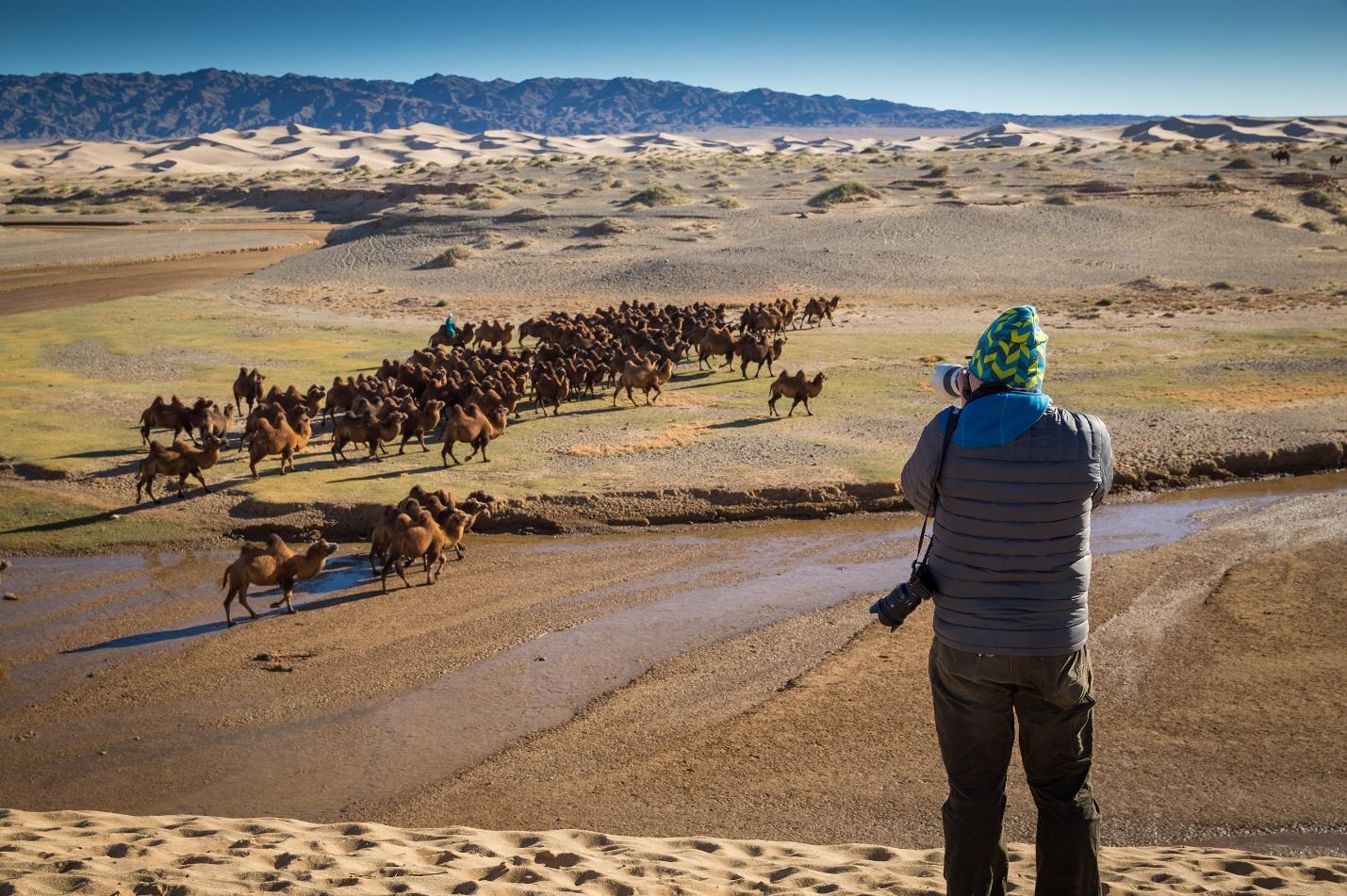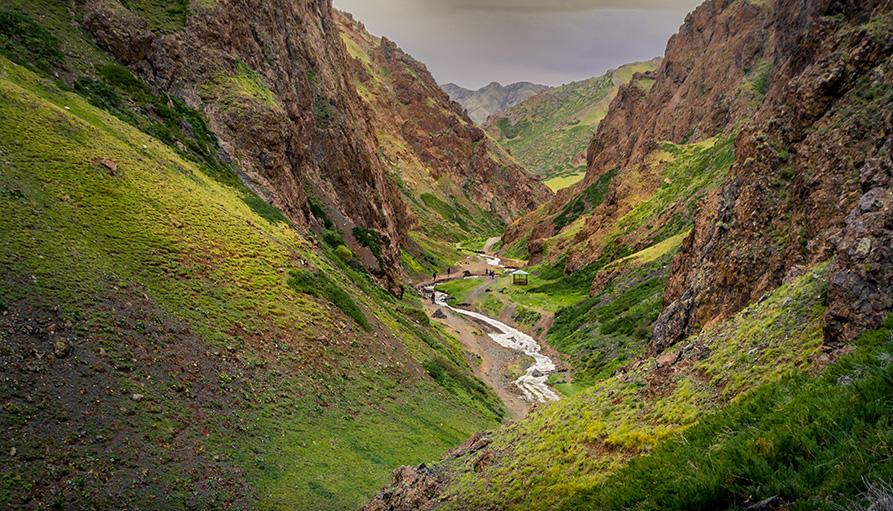Southern Mongolia
Most recommended tour destination places — such as the vast Gobi Desert, golden sand dunes, dinosaur fossil sites, unique rock formations, ancient petroglyphs, and camel herder culture — are located in the territory of Southern Mongolia. This makes Southern Mongolia one of the most exotic and unforgettable travel routes in the country.
~350,000 km²
Area

~+10°C
Average Temperature

~300,000
Population

~800–1,500 m
Elevation
Overview
Southern Mongolia, characterized by vast deserts, grasslands, and unique geological formations, offers a captivating blend of natural wonders and cultural heritage. Home to the provinces of Ömnögovi and Dundgovi, as well as the city of Dalanzadgad, the region experiences a desert climate with hot summers and cold winters, with temperatures ranging from 20°C to 30°C in summer and dropping below freezing in winter. This region holds significant historical importance, with ancient petroglyphs, dinosaur fossils, and remnants of the Silk Road dotting the landscape. Notable attractions include the Gobi Desert, the largest desert in Asia, renowned for its stunning sand dunes, rocky mountains, and rare wildlife such as the Bactrian camel and the Gobi bear. Travelers can also explore the Flaming Cliffs, known for their rich dinosaur fossils, and experience the nomadic lifestyle of the local herders. Accessible via flights or overland travel from Ulaanbaatar, Southern Mongolia offers a mesmerizing journey into a land of contrasts, where ancient history meets breathtaking natural beauty.
Khongor sand dunes


Khongoryn Els, also known as the Duut Mankhan or Singing Dunes, are among the most impressive sand dunes in Mongolia. Stretching up to 300 meters high, 12 kilometers wide, and approximately 100 kilometers long, these majestic dunes create a breathtaking sight against the backdrop of the stunning granite mountains. Nestled between the Altai Mountains to the south and lush green oases to the north, the dunes offer a mesmerizing landscape for adventurers.
What's cool about these dunes is that they make a singing sound when you climb them. As you trek up, the sand shifting beneath you creates a melodic hum. From the top, everything below looks tiny, and the peacefulness of the desert surrounds you.
Tourists flock to the Mongolian Gobi to witness the beauty of Khongoryn Els, particularly at sunset and sunrise, when the shifting colors of the sky cast a magical glow over the landscape. It's an experience that leaves a lasting impression, offering a glimpse into the vastness and serenity of the desert.
Eagle Valley Yol Am
Eagle Valley, also known as Yolyn Am in Mongolian, is a picturesque and narrow gorge located in the Gurvan Saikhan Mountains of the Gobi Gurvansaikhan National Park in southern Mongolia. It is situated in the southern part of Mongolia, within the Gobi Gurvansaikhan National Park. It is approximately 62 kilometers (38.5 miles) west of the town of Dalanzadgad, the capital of the South Gobi Province. The valley was formed by the movement of water over thousands of years, creating a deep and narrow gorge with steep rocky walls. During the winter months, the valley is known to be covered in ice, providing a stark contrast to the surrounding desert landscape. Eagle Valley is home to a variety of plant and animal species, including wild ibex, argali sheep, and various bird species. The valley is also known for its population of the endangered bearded vulture, also known as the lammergeier or bearded vulture. Due to its location in the Gobi Desert, Eagle Valley experiences extreme temperature fluctuations throughout the year. Summers can be hot with temperatures reaching over 40°C (104°F), while winters are cold with temperatures dropping below freezing. Eagle Valley is a popular tourist destination in Mongolia, attracting visitors who come to admire its stunning natural beauty and unique wildlife. Tourists can hike through the gorge, explore the surrounding mountains, and enjoy the peaceful and serene atmosphere of the valley. There is a small museum located near the entrance of Eagle Valley that provides information about the flora, fauna, and geology of the region. Visitors can learn more about the natural history of the area before exploring the valley itself.

Overall, Eagle Valley is a beautiful and tranquil natural attraction in Mongolia, offering visitors the opportunity to experience the diverse landscapes and wildlife of the Gobi Desert region.
Baga Gazriin Chuluu

Baga Gazriin Chuluu is a unique rock formation and a sacred site located in the Gobi Desert region of Mongolia. It is situated in the Dundgovi Province of Mongolia, approximately 15 kilometers (9.3 miles) to the north of Adaatsag sum (village). It is a remote and rugged area characterized by granite rock formations, hills, and valleys. Also, this place is known for its granite rock formations, some of which reach heights of up to 15-30 meters (49-98 feet). The site is surrounded by rocky hills and valleys, creating a unique and picturesque landscape in the otherwise flat Gobi Desert region. The area is considered sacred by the local nomadic herders and is believed to have spiritual significance. The site has historical and cultural importance, with ancient petroglyphs and Buddhist shrines scattered throughout the area. Despite its arid environment, Baga Gazriin Chuluu supports a variety of plant and animal species. Visitors may encounter wildlife such as wild sheep, ibex, marmots, and various bird species. The area also features unique flora adapted to the desert climate. While Baga Gazriin Chuluu is a remote location, it is accessible by road from the nearby town of Mandalgovi, the capital of Dundgovi Province.
Travelers can reach the site by car or join organized tours that include a visit to Baga Gazriin Chuluu along with other attractions in the Gobi Desert region. Overall, Baga Gazriin Chuluu offers a fascinating blend of natural beauty, cultural heritage, and outdoor adventure opportunities for those looking to explore the diverse landscapes of Mongolia's Gobi Desert.
Ongi Temple


Ongi Temple, also known as Ongi Monastery or Ongiin Khiid, is a historic Buddhist monastery complex located in the Saikhan-Ovoo District of Dundgovi Province in central Mongolia. Founded in the 17th century, Ongi Temple served as one of the largest and most important monasteries in Mongolia, consisting of two sections: Barlim Khiid on the north bank of the Ongi River and Khutagt Khiid on the south bank.
The monastery featured traditional Tibetan-style architecture with temples, stupas, prayer halls, and living quarters for monks adorned with intricate artwork, murals, and sculptures. Unfortunately, Ongi Temple fell victim to political upheaval and religious persecution during the communist era, leading to its destruction in 1939 and the dispersal of monks.
In recent years, efforts have been made to partially restore and rebuild the Ongi Temple complex, preserving its historical significance and cultural heritage. Despite not fully regaining its former glory, the monastery's ruins offer visitors a glimpse into Mongolia's Buddhist past and the role monasteries played in shaping the country's society and culture.
Today, Ongi Temple stands as a symbol of Mongolia's rich Buddhist heritage, attracting tourists interested in history, culture, and spirituality. Visitors can explore the monastery's ruins, visit the on-site museum, and experience the peaceful and scenic surroundings of the Ongi River valley, connecting with the country's past and cultural identity.
Bayanzag
Bayanzag, also known as the Flaming Cliffs, is a renowned archaeological and natural site situated in the Gobi Desert of Mongolia. Located in the Ömnögovi Province, about 95 kilometers northwest of Dalanzadgad, the provincial capital, Bayanzag features striking red sandstone cliffs that give the area its distinctive appearance. These cliffs, aptly named for their red and orange hues that seem to glow in the sunlight, create a captivating contrast against the desert landscape. Not only is Bayanzag known for its geological beauty, but it is also famous for its significant paleontological and archaeological discoveries. The Flaming Cliffs have yielded a treasure trove of dinosaur fossils and eggs dating back to the Late Cretaceous period, approximately 70 million years ago. The site gained international recognition when American paleontologist Roy Chapman Andrews discovered the first dinosaur eggs here in the 1920s.
In addition to dinosaur fossils, Bayanzag has revealed ancient stone tools and petroglyphs, shedding light on the prehistoric past and the early human inhabitants of the region. This rich history and diverse wildlife further add to the allure of the area.

Bayanzag is a popular destination for tourists seeking to explore its unique geological formations, view dinosaur fossils, and immerse themselves in the natural and cultural history of the Gobi Desert. Visitors can hike around the Flaming Cliffs, visit the nearby Saxaul Forest, and marvel at the breathtaking desert scenery. This beautiful place offers a captivating blend of natural beauty, geological wonders, and significant historical and archaeological discoveries, making it a must-visit destination for those interested in exploring Mongolia's rich natural and cultural heritage
Khamriin Khiid

Khamriin Khiid monastery was founded in the early 1820s by the renowned Mongolian intellectual and educator Danzanravjaa, who was a prominent figure in the 19th-century literary scene. The monastery served as a significant hub for the Buddhist "red sect" and was also known as the seat of the revered Gobiin Dogshin Noyon Khutagt, or the "Terrible Noble Saint of the Gobi". Danzanravjaa was a vocal critic of the societal norms of his time, challenging the prevailing class and gender divisions. He placed a strong emphasis on advancing public education, a mission he pursued at Khamriin Khiid monastery by establishing a comprehensive public school, theater, museum, and library.
One of the notable institutions within the monastery was the "Namtar duulakh datsan" (story-singing college), which was established in the 1830s and is acknowledged as Mongolia's earliest professional theater. In close proximity was the "Khuukhdiin datsan" (children's college), which provided fundamental and specialized artistic training to local children. Many of these children would go on to pursue careers as singers, dancers, painters, sculptors, and other artistic roles within the monastery or its affiliated theater group. Khamriin Khiid monastery was situated in a picturesque setting, characterized by a river lined with lush trees to the south and rocky mountains with numerous caves to the north, where the vibrant Saran Khokhoo drama echoed through the surroundings.
North of the monastery lay a series of caves where monks engaged in rigorous yogic practices and solitary meditation lasting 108 days, aiming to strengthen their physical bodies and enhance their spiritual capabilities. The area surrounding the monastery was rich in paleontological treasures, including fossilized dinosaur bones, petrified wood, and other rare remnants. Notably, paleontologists excavated the skeleton of the herbivorous dinosaur iguanodon, which thrived during the Cretaceous period millions of years ago. During its peak, Khamriin khiid monastery comprised four main sectors - East Khuree, West Khuree, Tsokhon, and Dunkher - housing four colleges (datsan), a children's school, over eighty temples, and a resident community of more than five hundred lamas. Tragically, the monastery met its demise in 1938 due to the military actions undertaken during the religious purges in Mongolia. Presently, efforts have been made to reconstruct two small ceremonial temples and various religious monuments at the site, with a contingent of more than ten resident lamas upholding the spiritual traditions of the monastery.